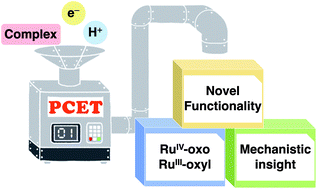Development of functionality of metal complexes based on proton-coupled electron transfer
Abstract
Proton-coupled electron transfer (PCET) is one of the ubiquitous and fundamental processes in various redox reactions performed by transition-metal complexes. In this article, we describe our remarkable achievements related to PCET in metal complexes, including proton manipulation of ligands to afford molecular bistability involving reversible intramolecular PCET and emergence of novel electronic structures, formation and reactivity of RuIV–oxo and RuIII–oxyl complexes, and mechanistic insights into PCET reactions from O–H and C–H bonds to RuIII–pterin complexes.

- This article is part of the themed collection: 2020 Frontier and Perspective articles


 Please wait while we load your content...
Please wait while we load your content...